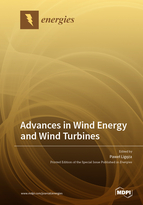Advances in Wind Energy and Wind Turbines
A special issue of Energies (ISSN 1996-1073). This special issue belongs to the section "A3: Wind, Wave and Tidal Energy".
Deadline for manuscript submissions: closed (31 December 2022) | Viewed by 19913
Special Issue Editor
Interests: metrology; electronics; energetics; mechanics; mechatronics; robotics; computer sciences; modelling and control; mining sciences; measurement systems; flow metrology
Special Issues, Collections and Topics in MDPI journals
Special Issue Information
Dear Colleagues,
We live on a planet immersed in an ocean of air. The existence of the atmosphere is essential to our life. We breathe, experience acoustic sensations, and are cooled by gusts of wind. We sail and move using the wings of aircraft. We also experience many negative, destructive phenomena such as hurricanes, typhoons, tornadoes, and cyclones. Air, atmosphere, and wind are elements of nature, which remains in constant motion, manifesting itself in turbulence, chaos, but also—and most importantly to us—in the transport of huge amounts of energy. Conscious obtaining of this energy to meet the needs of our civilization is a continuous interdisciplinary challenge. This process requires solving many key problems, not only technical and technological, but also in many other, even very distant, scientific fields.
Therefore, having the honor of being the Guest Editor of this Special Issue, I invite my colleagues, researchers, and experts in all scientific disciplines who research issues related to the broadly understood wind energy to share the results of their research in the Special Issue of the Energies journal on “Advances in Wind Energy and Wind Turbines”. The subject of the publications should correspond to the title of the Special Issue, and you will find thematic tips in the keywords. However, I encourage you to prepare a paper both in terms of the indicated topics, as well as in the other fields of wind energy, which you consider important and worth presenting to a wider scientific community. As researchers, we have a special influence on the development and improvement of energy obtaining and processing methods, while bearing in mind our responsibility for the condition and fate of our planet. Feel free to publish your research in this Special Issue!
Prof. Dr. Paweł Ligęza
Guest Editor
Manuscript Submission Information
Manuscripts should be submitted online at www.mdpi.com by registering and logging in to this website. Once you are registered, click here to go to the submission form. Manuscripts can be submitted until the deadline. All submissions that pass pre-check are peer-reviewed. Accepted papers will be published continuously in the journal (as soon as accepted) and will be listed together on the special issue website. Research articles, review articles as well as short communications are invited. For planned papers, a title and short abstract (about 100 words) can be sent to the Editorial Office for announcement on this website.
Submitted manuscripts should not have been published previously, nor be under consideration for publication elsewhere (except conference proceedings papers). All manuscripts are thoroughly refereed through a single-blind peer-review process. A guide for authors and other relevant information for submission of manuscripts is available on the Instructions for Authors page. Energies is an international peer-reviewed open access semimonthly journal published by MDPI.
Please visit the Instructions for Authors page before submitting a manuscript. The Article Processing Charge (APC) for publication in this open access journal is 2600 CHF (Swiss Francs). Submitted papers should be well formatted and use good English. Authors may use MDPI's English editing service prior to publication or during author revisions.
Keywords
- advanced technologies in wind energy
- modeling and validation of wind turbines
- metrology and instrumentation in wind energy
- concentrated and distributed wind energy
- network management algorithms
- optimal location of wind farms
- transport and assembly of wind turbine components
- risk management in wind energy
- threats to people, animals, and the environment
- electromagnetic interferences in wind energy
- small and local wind turbines
- social, economic, legal, and political problems






